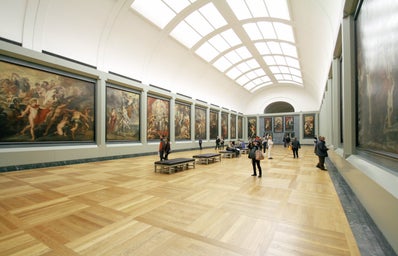As a fun leisure activity, art museums are a great way to spend your time. Whether you are an art or art history enthusiast, or simply a person that likes looking at pretty things (most of the time), spending quiet time at an art museum can be incredibly rewarding. However, it’s not just looking at the pretty art that I find extremely interesting and enjoyable. I believe that museums, and specifically art museums, can offer immense satisfaction to your inner self, through mindfulness and stepping out of your visual comfort zone.
When you think of an art museum, images of the renaissance, women in royal garb, and landscapes naturally come to mind. Sure, they’re pretty, but you can look at pretty things from the comfort of your own home if you so choose to. Yet stepping into an art gallery or a room of an art museum offers a different perspective. Entering a vast room, being able to look around you and seeing aesthetically pleasing art wherever you turn your head to, offers a fresh outlook on art itself.
Maybe you’re drawn to a piece of art not because of what it looks like, but because of the feeling that it evokes from you. Emotion, of course, is naturally tied to art, but once you’re in the art museum, you can’t necessarily pinpoint why a particular piece moves you in a certain way. It might invoke a sense of melancholy – longing. Instead, the colors and abstraction of an art piece may make you feel energized, inspired – ready to take on the world. Regardless of the emotion, the fact that art itself as an image can evoke strong feelings that you cannot readily describe to yourself invites all the more excitement and joy with being in a space where you can be influenced in such a way.
If you choose to focus on a piece, it can look magnificent from a hop and a skip away. Maybe the art is incredibly detailed, almost reminiscent of a photograph. Or, perhaps, the art looks somewhat hazy or abstract, offering a more cohesive look when farther away. By stepping closer to an art piece, you’re able to see the intricate details of the art itself – the individual brush strokes that curve and point to different directions, the use of color and how they lay next to each other, the almost three dimensional aspect of the layers and layers of paint. It takes you away from the overall deposit of the art, but makes you realize the complexity of what it’s taken for the art to present itself to you as a cohesive image.
Once you’re drawn to a piece of art, look at its composition and complexity. You might notice a title or description in your periphery further explaining the art itself. This is by far my favorite part – the information by and about the piece is what drives me to attend art museums and galleries. The background and story of art can sometimes provide you a completely different perspective of the piece. A normal portrait of a dog sitting in a meadow may make you feel fuzzy or think, wow, what a cute dog, but it’s description can move you in a way that would probably not been possible if you were restricted to only gazing at the art (this happened to me in the Toledo Museum of Art).
Instead of being a very detailed and lifelike portrait of a cute dog in nature, the artist’s name (a little known painter), no worthwhile title, and description that the dog’s breed is now extinct due to lack of public interest provide the context that whoever the owner, whatever the name of the dog, and wherever the location, the pouring of love is evident in the detail that the artist had for this unnamed, extinct dog. These descriptions can offer anything from what the art is composed of and how it was made, to a biography of the artist or further context of the meaning behind the art and its hopeful message. Regardless of the description, the intent of these writings almost always provides the viewer the ability to look outward of themselves and find deeper appreciation of the art itself.
Stepping back, you realize that the art all around you is from artists from different countries, different backgrounds and livelihoods, and is depicting different circumstances within different historical time frames. The feeling is almost overwhelming – you are standing amongst art that has been favored so much that it has been preserved for potentially hundreds of years. You realize that you are essentially looking within a time capsule to a moment that you will never be able to experience, yet you are able to experience it within the eyes of the artist.
All of these aspects coincide into an intimate moment within yourself and the time and space around you. You’re unable to remember all the paintings, sculptures, or exhibits that you see. Yet, the mindfulness you receive from being in such an environment can hardly be recreated elsewhere. Simply having the knowledge that you enjoyed yourself, you looked at pretty things, it made you think, and more importantly, it made you feel, is enough to set you apart from yourself and take a moment to indulge with the beauty around you. If anything at all, art museums give you the capacity of seeing beauty in things that otherwise you might disregard or not see as beautiful. Whatever emotions you may feel day to day, whatever sights you see or stresses that impact you, you may be able to take a step back and notice it through an artist’s eye.


